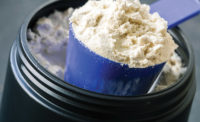
Innovations For Life
by Lori Dahm
Ingredients and technologies make the newest dairy
products healthier.
Many innovative new dairy
products introduced this past year were possible because of the latest
ingredient technologies — for example, the smooth-textured frozen
desserts utilize emulsifiers and texture systems, while big news in yogurts
and drinkable yogurts was the addition of probiotic cultures.
And, of course, while the industry is still struggling
with how best to publicize and use the latest whey research, the scientific
community is on fire with the results from human clinical trials which
document and validate the significant health benefits whey can impart.
The use of various ingredients in dairy applications
continues to revolutionize the types of products available to consumers
— improved products in terms of mouthfeel and other sensory
attributes, and healthier products, whether that be through the addition of
live and active cultures or through the removal of less desirable
substances like sugars. The world of dairy products continues to progress
due to these newest ingredient technologies.
Going Pro
The inclusion of probiotic cultures in dairy products
is finally hitting its stride, after five to 10 years of experts positing
that consumers were ready to embrace the probiotic concept. As defined by
the World Health Organization (WHO), probiotics are live microorganisms,
which when administered in adequate amounts confer a health benefit on the
host.
“The most essential traits of probiotics are
their ability to resist stomach acid, bile salts and digestive enzymes;
their capability to adhere to intestinal mucosa and cohabit with indigenous
intestinal microflora, or to produce substances that suppress the growth of
undesirable bacteria without damaging the endogenous intestinal
flora,” says Mirjana Curic-Bawden, senior scientist at Chr. Hansen,
Milwaukee. “These characteristics are strain specific. Furthermore,
probiotics must be stable in food applications.”
Probiotic cultures have been a part of dairy products
in other countries for decades. Kefirs and fermented dairy beverages on the
market in Europe and Asia have traditionally included live and active
cultures, and consumers there are familiar with the health benefits that
probiotic cultures confer, such as gut health, immunity and other
attributes.
“We are observing trends in products in the
United States that are just the tip of the iceberg of the popularity that
similar products have received in Europe and Asia for the past two
decades,” Curic-Bawden says. “Fermented milk is undoubtedly the
most popular application worldwide, as it offers a wide variety of
different product types, from stirred yogurt and drinkable yogurts to
diluted fermented beverages.”
As well, new products are appearing in the global
market, and signs indicate that soon these new products will cross the
ocean and make an appearance in the United States.
“Last year, we also observed an increased
interest in applications of probiotics in fresh and hard cheeses, ice
creams, frozen desserts and fruit juices,” Curic-Bawden says.
“A range of new dairy-based products was recently launched in Europe
and Asia, fermented whey or fermented skim milks blended with orange juice
or fruit cocktails. These types of products are very innovative; they are
usually formulated to deliver combined health benefits of whey proteins,
probiotics, vitamins and very often prebiotic fibers or phytonutrients and
antioxidants.”
For the present status of probiotics here on this
continent, use of live and active cultures is appearing primarily in
yogurt-type products, which are particularly suitable for probiotics
because of the other cultures within the yogurt formulation.
“One reason that yogurt and fermented milk
products are almost always considered traditional carriers of probiotics is
because some probiotic strains (most of them belonging to lactic acid
bacteria) can grow to a certain extent during the incubation of
milk,” Curic-Bawden says. “However, probitoics can also be used
in dairy applications such as cheeses, like cream cheese, semi-hard and
hard cheeses. In any case, it is of utmost importance that the probiotic
strains survive during the shelf life (6 to 12 months in hard cheese), but
do not have a negative effect on the taste of the final product.”
It is this survival through the shelf life of a product
that is particularly important in the field of probiotic-laden products. To
deliver a beneficial effect, probiotics must be ingested in adequate
amounts, which generally are considered a minimum of 100 million live and
active probiotic cells per serving, although the trend is now moving toward
an even higher count.
“Achieving a high count in a freshly fermented
product is almost always a matter of inoculation rate and growth
(incubation) conditions,” Curic-Bawden says. “Keeping the
high cell count for 50 to 60 days, which is now tending to be a standard
shelf life of fermented milk in the U.S., depends on numerous factors
such as the pH of the product, the presence of dissolved oxygen,
the addition of various preservatives and storage temperature.”
Most probiotics currently being used in the food
industry belong to one of the following genera and species: Bifidobacterium lactis, Bifidobacteriuim longum, Lactobacillus acidophilus or Lactobacillus rhamnosus.
In order for the human benefit of the probiotic strain
to be valid, in vitro and in vivo studies that include human clinical
studies must have been conducted. Documented probiotic strains have the
unique strain designation (letters and/or numbers), so they can be easily
identified in the research literature and distinguished in the market. In
most cases, credible probitoics are also protected with a trademark.
“We are continually working on the promotion of
probiotics and the education of our customers on the benefits of
probiotics,” Curic-Bawden says. “Probiotics are an important
segment of the global functional food trends. They are finally entering the
U.S. through the front door, and our impression is that they are here to
stay and expand.”
Frozen Wonderland
The ice cream and frozen dessert category this past
year was a playground for new ingredients that enabled products to deliver
improved sensory attributes like the mouthfeel of full-fat ice creams in
products with lower fat levels.
“There is a new wave of ‘light’ ice
cream products. National brands have been achieving the desired texture
through the use of low-temperature extrusion processes. Many of the
smaller, regional companies have turned to texture system technology to get
a similar result without the large capital expense,” says Don
Heffner, market manager of frozen desserts at Kerry Bio-Science, Hoffman
Estates, Ill. “As the frozen dessert industry moves toward more lower
fat and ‘better-for-you’ products, the use of texture systems
has helped to make many of these products ‘eat’ closer to their
original counterparts.”
The new “light” ice cream and frozen
dessert products that are light tend to have significantly reduced fat
levels, as much as 50 to 70 percent below that of regular ice creams.
“We have found that the selection of the right
emulsifier system can give the impression of higher fat levels. The key to
this texture and proper air cell stability is optimizing the level of fat
agglomeration,” Heffner says. “In addition, the
‘light’ products typically have higher overrun levels and
slightly lower total solids than regular ice creams. These factors make it
necessary to adjust the hydrocolloid system to properly maintain the air
cell structure and minimize the effects of more free water in the
product.”
Many of the new ice creams and frozen desserts this
year offered lowered sugar levels, and such formulations required that
traditional sweeteners such as sucrose and corn syrup be replaced with
alternative sweeteners that could provide bulk and the desired sweetness
level.
“Using sugar alcohols such as sorbitol or
lactitol in frozen desserts provide only a low level of sweetness, but add
solids and aid in reducing the freezing point to an appropriate
temperature,” says Linda Dunning, group manager of frozen desserts
and beverages at Danisco USA, New Century, Kans. “Polydextrose and
maltodextrin are often added to replace the solids and add back the body
that is lost with the removal of traditional sweeteners.”
Using such ingredients provides a reduction in calories
compared to traditional formulations, and some formulations include a blend
of sucralose, aspartame and acesulfame potassium in no-sugar-added products
to provide the desired level of sweetness.
“However, the recent trend has been to use
traditional sweeteners with little or no high-intensity sweeteners to
create a reduced-sugar product. This application area has a huge potential
in a nation that has a growing number of obese children,” Dunning
says. “Some parents are not willing to give their children sugar
alcohols or high-intensity sweeteners, but they also want to help reduce
their children’s sugar intake. Reduced-sugar products that use
traditional sweeteners with little or no high-intensity sweeteners can meet
this need and have a potential use in school lunch programs.”
Other areas of future growth and opportunity are for
both texturizer ingredients and sweetener alternatives that can be part of
a clean-labeled product. Although the “organic” designation is
not as critical for these ingredient systems — because they comprise
such a minimal percentage of the formulation and thereby escape
“organic” derivation requirements — having such products
be all-natural is becoming increasingly important for the clean-label
consideration.
“As well, there is a large amount of work being
done in the area of ‘anti-freeze’ proteins for use in frozen
desserts,” Heffner says. “These products attempt to exploit the
ability of certain organisms to survive in sub-freezing environments
through the use of naturally produced proteins that prevent freezing of
water in living cells.”
Whey
Of course, the dairy industry has been excited about
the potential of whey as an ingredient for the past several years, as the
health benefits that whey can impart have become more widely known and
substantially documented. Whey as an ingredient is making a showing in many
nutritional bars which boast an amplified protein quotient, as well as in
some new emerging beverages, also as a protein source.
This is no small wonder, considering that the most
recent studies reveal that whey protein has significant power and potential
for its healthy attributes. Dairy Management Inc. (DMI), Rosemont, Ill.
hosted a Whey Symposium at this year’s IFT Annual Meeting
— titled “Whey Protein: Physiological Effects and
Emerging Health Benefits” — that presented several new
promising studies conducted with whey with regard to muscle synthesis,
weight management and satiety, and even some preliminary anti-carcinogen
studies.
“Research reported by Dr. Stuart Phillips at
McMaster University in Hamilton, Ontario, showed that milk protein
administered after exercise revealed that the combination of whey protein
with casein have a positive synergistic effect on muscle protein synthesis
and retention. The amino acids from the whey and from casein are both
responsible for milk protein being more effective in muscle recovery than
other proteins,” says Pete Huth, director of regulatory and research
transfer at DMI. “Whey protein is a fast absorbing protein so its
amino acids are rapidly absorbed into the bloodstream and reach the muscle
tissue quickly to stimulate protein synthesis, whereas casein is a slower
absorbing protein that has been shown to suppress the normal process of
muscle protein breakdown.”
Phillips’s research shows that these two dairy
proteins have a complementary effect of promoting muscle protein
development leading to building the overall muscle in the body.
In other human clinical studies presented at the
conference, consumption of whey protein by overweight and obese subjects
for six months resulted in significant reductions in body weight and fat
with no change in lean body mass compared to a carbohydrate-controlled
diet. Another study documented the effect of whey and other dairy proteins
upon increasing satiety and reducing food intake.
Extremely preliminary work in animal studies was
reported on the tumor suppression effects resulting from the ingestion of a
whey protein fraction that is an iron-saturated form of lactoferrin. But
while whey ingredients are appearing in new products on the shelf, the
specifics of these promising health studies have yet to make their way into
the consciousness of the typical consumer.
“Consumer awareness of whey continues to grow,
and certain segment of the population such as athletes and fitness
enthusiasts are already consuming whey protein due to its numerous health
benefits,” Huth says. “Consumer research indicates that once
consumers are made aware of the benefits of whey protein, the notion
resonates well and they immediately make the connection and are open to
whey ingredients.”
Overall, the ingredients that are a part of innovative
dairy products within this past year helped amplify the health quotient,
whether that be through the addition of ingredients like whey for a protein
benefit or probiotics for health attributes, or through the use of
ingredient systems to compensate for the removal of substances like sugars
or fat. Consumers have benefited from the improved products that resulted
from these new ingredients and technologies.
$OMN_arttitle="Innovations For Life";?>

